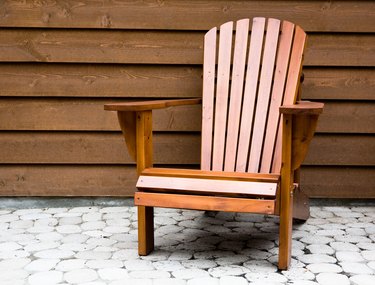
Just like most protective topcoats, such as polyurethane or varnish, a topcoat of lacquer will prevent stain from absorbing into a wood surface. If you try to apply stain to a lacquered surface, the stain will simply bead up and drip off. If you want to stain a lacquered piece of wood furniture, you will need to strip the lacquer from the surface and refinish the piece completely.
Preparing the Workspace
Video of the Day
Before you work with any of the chemicals needed for this process, open all of the windows in the area where you're working to allow for proper air circulation. Stains, lacquers, polyurethane, stain strippers and paint strippers give off toxic fumes. Tape off any areas that you do not want affected by strippers and stains. If it's feasible, lay a drop cloth under the work area.
Video of the Day
Stripping the Lacquer and Stain
There are many types of varnish and lacquer removers that take off not only a protective topcoat but some of the stain as well. Apply stain stripper directly to the wood surface and let it sit for a few minutes -- the wait time varies by product. The lacquer and stain will start to bubble and peel. Scrape the wood surface with a paint scraper or putty knife to remove the lacquer and stain. Use a gel-based product for vertical surfaces to help prevent spillage. Once you have removed the majority of the lacquer, you will need to sand the surface by hand or with a power sander until you get to the bare, unstained wood.
Cleaning the Surface
There will most likely be some residual chemicals, lacquer and stain left over when you are finished stripping the wood surface. Since the chemicals from the stripper have already broken down the lacquer and stain, you can remove all of it with a rag or soft-bristled scrub brush and a solution of 1 cup tri-sodium phosphate and 4 gallons of water. Scrub the entire surface of the wood and allow it to dry completely. Use more or less of the solution, in the same ratio, depending on the size of your project.
Restaining and Sealing
Now that you're down to the proverbial clean slate, you can finally re-stain the wood with the stain of your choice. Spread the stain over the surface with a brush, a roller or rag. Work in small sections and wipe up any stain that pools on the surface with a clean cloth. Keep wiping until no more stain comes off the wood onto the rag. When you are satisfied with the look of the stain, allow it to dry then apply a protective topcoat, such as lacquer, varnish or polyurethane.